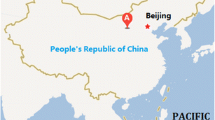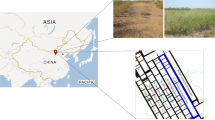Abstract
Prior studies have indicated that mining-induced surface dynamic cracks in eastern China only undergo one “expanding-closure” development cycle. However, field measurements from the Bulianta mines of northwestern China demonstrated that ground dynamic cracks in the Ordos region went through two “expanding-closure” cycle. Using in situ measurement data and theoretical analysis, we find that the strata control theory cannot reasonably explain this special phenomenon. In this paper, we propose a novel explanation from the perspective of soil mechanics. A comparison of two field examples in eastern and northwestern China demonstrates that our theoretical explanation is in agreement with in situ observations and therefore is a reasonable interpretation for the secondary development of ground dynamic cracks in the Bulianta mines. This study provides a theoretical basis for the mechanism of mining-induced ground dynamic cracks.
Similar content being viewed by others
Notes
Specifications for the first-order leveling and second-order leveling in China, GBT12897-2006.
References
Bi YL, Zou H, Zhu CHW (2014) Dynamic monitoring of soil bulk density and infiltration rate during coal mining in sandy land with different vegetation. Int J Coal Sci Technol 1(2):198–206
Dunrud CR, Osterwald FW (1980) Effects of coal mine subsidence in the Sheridan, Wyoming, area. Center for Integrated Data Analytics Wisconsin Science Center, Middleton
Hu ZHQ, Wang XJ, He AM (2014) Distribution characteristic and development rules of ground fissures due to coal mining in windy and sandy region. J Chin Coal Soc 1:11–18 (in Chinese)
Li L, Wu K, Hu ZHQ, Xu YK, Zhou DW (2017) Analysis of developmental features and causes of the ground cracks induced by oversized working face mining in an aeolian sand area. Environ Earth Sci 76(3):135
Ni XH, Wang FQ (2014) Technical study and practice of thick coal mining under watercourse in Technical study and practice of thick coal mining under watercourse in Yanzhou mining area. China University of Mining and Technology Press, Xuzhou, p 202 (in Chinese)
Palchik V (2003) Formation of fractured zones in overburden due to longwall mining. Environ Geol 44(1):28–38
Prakash A, Kumar A, Singh KB (2014) Dynamic subsidence characteristics in Jharia Coalfield, India. Geotech Geol Eng 32(3):627–635
Singh TN, Singh DP (1992) Prediction of instability of slopes in an opencast mine over old surface and underground workings. Int J Surf Min Reclamat Environ 6(2):81–89
Sirdesai NN, Singh R, Singh TN, Ranjith PG (2015) Numerical and experimental study of strata behavior and land subsidence in an underground coal gasification project. Proc IAHS 372:455–462
Song YX (2011) Test study on the mechanical property of the aeolian sand and the bearing capacity of the aeolian sand ground of Mu Us Desert. Chang’an University, Xi’an (in Chinese)
Taylor DW (1948) Fundamentals of soil mechanics. LWW 66(2):161
Terzaghi K (1943) Theoretical soil mechanics, vol 18. Wiley, New York
Verma AK, Saini MS, Singh TN, Dutt A, Bajpai RK (2013) Effect of excavation stages on stress and pore pressure changes for an underground nuclear repository. Arab J Geosci 6:635–645
Wang XJ (2014) Monitoring, evolution and self-healing characteristic of land damage due to high tension coal mining in windy and sandy area. China University of Mining and Technology, Beijing (in Chinese)
Wu K, Li L, Ao JF, Hao G (2010) Discussion on limit development depth of cracks in surface soilmass caused by mining subsidence. Coal Sci Technol 38:108–111 (in Chinese)
Xu YK, Wu K, Li L, Zhou DW, Hu ZHQ (2017) Ground cracks development and characteristics of strata movement under fast excavation: a case study at Bulianta coal mine, China. Bull Eng Geol. doi:10.1007/s10064-017-1047-y
Yuan L, Wu K (2003) Technical study and practice of thick coal mining under watercourse in Theoretical study and technology practice of coal mining under Huaihe River embankment. China University of Mining and Technology Press, Xuzhou (in Chinese)
Acknowledgements
This work was supported by the Natural Science Foundation of China and Shenhua Group Co., Ltd (Grant No. U1361203). The authors would like to thank the editor and reviewers for their contributions to the paper.
Author information
Authors and Affiliations
Corresponding author
Rights and permissions
About this article
Cite this article
Xu, Y., Wu, K., Bai, Z. et al. Theoretical analysis of the secondary development of mining-induced surface cracks in the Ordos region. Environ Earth Sci 76, 703 (2017). https://doi.org/10.1007/s12665-017-7050-6
Received:
Accepted:
Published:
DOI: https://doi.org/10.1007/s12665-017-7050-6













